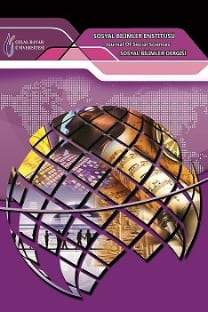Avrupalı Seyyahların Gözüyle Seydiköy ve Çevresi
Bu çalışmada Seydiköy’ü 17. yüzyıldan itibaren ziyaret etmeye başlayan Avrupalı seyyahların gezi anekdotlarında verdiği bilgiler ve 2018 yılında tarafımızdan gerçekleştirilen arkeolojik yüzey araştırması sırasında elde edilen bulgular üzerinden kentin arkeolojik ve kültürel mirasının mevcut durumu ile değişimi değerlendirilmiştir. Seydiköy’ü 17. yüzyıldan bu yana ziyaret eden Avrupalı seyyahlar yerleşim hakkında paylaştıkları genel bilgiler dışında bölgenin antik kalıntıları üzerine de gözlemlerini sunmuşlardır. Özellikle Seydiköy ve çevresinin Avrupa müzelerine eski eser sağlayabilecek bir arkeolojik zenginliğe sahip olduğu bu şekilde öğrenilmektedir. Sonrasında gerçekleştirilen araştırmalar da yörenin antik çağda Smyrna’ya uzanan güzergâh üzerinde stratejik bir noktada olduğunu göstermekle birlikte kentin büyüme ve gelişme sürecinde birçok antik kalıntının kaybolmuş olduğu görülmektedir. Örneğin birçok seyyahın gezi anekdotları içerisinde adı geçen tümülüslerden günümüzde yalnızca bir tanesinin muhafaza edilebilmiş olması bunun kanıtı niteliğindedir. Önceki araştırmalarda ve tarafımızdan gerçekleştirilen yüzey araştırması sırasında yörede arkeolojik bulgulara ulaşılması da erken dönem seyyahlarının Seydiköy’ün antik kalıntılarına ilişkin vurgularını desteklemektedir.
Anahtar Kelimeler:
Seydiköy, Yüzey Araştırması, Arkeoloji, Seyyahlar
Seydiköy and Its Surroundings From the Eyes of European Travelers
In this study, the information given in the anecdotes of European travelers, who started to visit Seydiköy from the 17th century, and the findings obtained during the archaeological survey conducted by us in 2018 were evaluated with the current state of the archaeological and cultural heritage of the city. Besides the general information they shared about the settlement, the European travelers who visited Seydiköy since the 17th century also presented their observations on the ancient ruins of the region. Especially, it is learned that Seydiköy and its surroundings have an archaeological prosperities that can provide ancient works to European museums. Afterwards, the researches show that the region is at a strategic point on the route extending to Smyrna in ancient times but many ancient ruins have been lost in the city's growth and development process. In previous researches and during the survey conducted by us, reaching the archaeological findings in the region also supported the early travelers of ancient ruins of Seydiköy.
Keywords:
Seydiköy, Survey, Archaeology, Travelers,
___
- Arundell, FR. V. J. (1828). Visit to the Seven Churches of Asia, with an Excursion Into Pisidia; Containing Remarks on the Geography and Antiquities of Those Countries, London. Bent, J. T. (2016). Early Voyages and Travels in the Levant: I.- The Diary of Master Thomas, Routledge. Bond, A. (1828). Memoir of the Rev. Pliny Fisk, A.M. Late Missionary to Palestine, From the American Board of Mission, Edinburgh. Cadoux, C. J. (2003). İlkçağ’da İzmir: Kentin, En Eski Çağlardan İ.S. 324’e Kadar Tarihi, çev. B. Umar, İstanbul. Chandler, R. (1817). Travels in Asia Minor, Society of Dilettanti, London. Cricca, A. (1868). Cholera in the Orient, and Its Successful Treatment, and Prophylaxis, in the Epidemic of 1865, Chicago. Davis, E. J. (1874). Anatolica: Or, The Journal of a Visit to Some of the Ancient Ruined Cities of Caria, Phrygia, Lycia, and Pisidia, London. Dearborn, H. A. S. (1819). A Memoir on the Commerce and Navigation of the Black Sea and the Trade and Maritime Geography of Turkey and Egypt, Vol. II, Boston. Doğer, E. (2006). İzmir’in Smyrnası Paleolitik Çağ'dan Türk Fethine Kadar, İstanbul. Emerson J. (1829). Letters from the Ægean, New York. Fellows, C. (1838). A Journal written during an Excursion in Asia Minor, Londra. Frankel, R. (2003). The Olynthus Mill, Its Origin, and Diffusion: Typology and Distribution, American Journal of Archaeology, 107 (1), 1-21. Fuller, J. (1830). Narrative of a Tour Through Some Parts of the Turkish Empire, London. Hasselquist, F. (1766). Voyages and Travels in the Levant in the Years 1749, 50, 51, 52: Containing Observations in Natural History, Physick, Agriculture, and Commerce, Particularly on the Holy Land and the Natural History of the Scriptures, London. Jardine W. (1858). Memoirs of Hugh Edwin Strickland, Cambridge. MacGill, T. (1839). Travels in Turkey, Italy and Russia During the Years 1803, 1804, 1805, 1806; with an Account of some of the Greek Islands Vol. I, London. Magie, D. (1950). Roman Rule in Asia Minor, Volume 2 (Notes): To the End of the Third Century After Christ, Princeton. Meriç, R. (1988). 1986 Yılı İzmir ve Manisa İlleri Yüzey Araştırmaları, V. Araştırma Sonuçları Toplantısı I, Ankara. Meric, R. & Nollé, J. (1988). Eine archaische Inschriftaus dem Gebiet von Smyrna, Chiron 18, 225-232. Michoud, J. F. & Poujoulat, J. J. F. (2007). İzmir’den İstanbul’a Batı Anadolu 1830, Çev. N. Demirtaş, İstanbul. Ramsay, W. M. (1960). Anadolu’nun Tarihi Coğrafyası, İstanbul. Tuna, N. (1988). İonia ve Datça Yarımadası Arkeolojik Yüzey Araştırmaları 1985 – 1986, V. Araştırma Sonuçları Toplantısı I, Ankara. Walpole, R. (1820). Travels in Various Countries of the East; Being a Continuation of Memoirs relating to European and Asiatic Turkey, London. Weber, G. (1885). Akdsché – Kaja. Eine unbekannte Felsburg bei Smyrna, Mittheilungen des Deutschen Archaologischen Institutes in Athen, Athen, 211-216. Wheler, G. (1682). Journey Into Greece. 6 Books with Variety of Sculptures, London.
- ISSN: 1304-4796
- Yayın Aralığı: Yılda 4 Sayı
- Başlangıç: 2003
- Yayıncı: Manisa Celal Bayar Üniversitesi
Sayıdaki Diğer Makaleler
II. Meşrutiyet Dönemi İzmir’den Amerika’ya İhraç Edilen Ürünler (1909-1911)
Organizasyonel Öğrenme, Adımları ve Uygulanması
Ebeveyn Tutumları İle Yetişkin Ayrılık Kaygısı Arasındaki İlişkinin İncelenmesi
Ebru SAVAŞLI, İkbal Tuba ŞAHİN SAK
Bir Terörle Mücadele Stratejisi Olarak Belediyelerde Kayyum Uygulaması
Turizm Master Planlarının Karşılaştırılması: Türkiye Örneği
Esra KATIRCIOĞLU, Mehmet BOYRAZ, Ahmet ÇETİN, Hasan Hüseyin SOYBALI
Sosyal Dışlanma Olgusu Üzerine Genel Bir İnceleme
Ticari Açıklık, İstihdam ve Enflasyon İlişkisi: Türkiye Örneği
Deniz ŞİMŞEK, C. Erdem HEPAKTAN
Algılanan Kurumsal Sosyal Sorumluluğun Satın Alma Niyeti Üzerindeki Etkisinde Güvenin Aracılık Rolü
